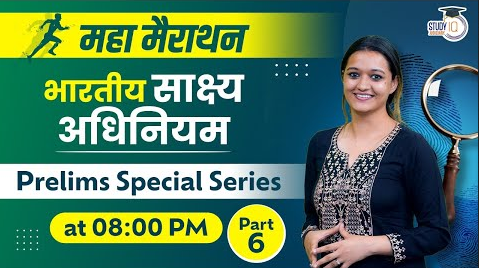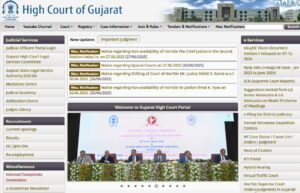Q1. In Evidence Act the facts of which judicial notice is to be taken are stated in
- Section 55
- Section 56
- Section 57
- Section 58
Explanation: 3
- Facts need to be proved by way of adducing evidence in the Court of law. Evidence must be produced in accordance with the procedures mentioned in The Indian Evidence Act, 1872 for being admissible. The doctrine of judicial notice is an exception to this rule.
- The doctrine of judicial notice is that certain facts do not need to be proved as the Court is deemed to have knowledge of those facts. These facts are very general and well known by everyone and proving them would be dishonour of the Court. Ron was in Japan this weekend.
- It is essential to prove whether or not Ron was actually in Japan this weekend, but the Court knows that Japan is a real country that really exists, thus, there is no need to prove the existence of Japan.
- Such simple facts are to be judicially noticed in order to save time and effort of both the Court and the parties.
Q2. Which of the following facts are required to be proved?
- All laws in force in the territory of India.
- Public festivals and holidays notified in official Gazette.
- The Rules of the road.
- None of the above.
Explanation: 4
- All laws that are effective within the territory of India.
- The Court is expected to know the law of the land. Any law that is in force in the territory of the country must be known by the Court, and either of the parties is not required to prove the existence of any such law.
Q3. Contents of a documents under Section 59 of the Indian Evidence Act, 1872
- can be proved by oral evidence
- cannot be proved by oral evidence
- may or may not be proved by oral evidence
- can only be proved by oral evidence under the orders of the court
Explanation: 2
- All the facts and circumstances may be proved by oral evidence by expressing or speaking except the contents of documents and electronic records. The contents of documents and electronic records cannot be proved by oral evidence. It is held that if any person has to be called for proving their documents then that document becomes oral and documentary evidence loses its significance.
- It was held in Bhima Tima Dhotre v. The pioneer chemical co. that “Documentary evidence becomes meaningless if the writer has to be called in every case to give oral evidence of its contents. If that were the position, it would mean that, in the ultimate analysis, all evidence must be oral and that oral evidence would virtually be the only kind of evidence recognised by law.
Q4. A witness who is unable to speak, gives his evidence by writing in open Court. Evidence so given shall be deemed to be-
- Oral evidence
- Documentary evidence
- Primary evidence
- Secondary evidence
Explanation: 1
- Dumb witnesses.—A witness who is unable to speak may give his evidence in any other manner in which he can make it intelligible, as by writing or by signs; but such writing must be written and the signs made in open Court. Evidence so given shall be deemed to be oral evidence.
Q5. H‘ says that Y told him that ‘A’ killed B’. This –
- Primary evidence
- Best evidence
- Hearsay evidence
- Admission
Explanation: 3
- Hearsay is any information which is received by any person from any other source. Hearsay means when a person does not have a personal knowledge about a particular matter or incident and he has been informed about that particular matter by any other person.
- As oral evidence includes first-hand knowledge thus, Hearsay evidence is excluded under the ambit of oral evidence because hearsay is not directly obtained evidence.
Q6. If X is charged with Y’s murder, which of the following will be a hearsay evidence.
- Z, in his evidence, states that “I saw X stabbing Y with a knife”.
- Evidence of A that “Z told me that he had seen X stabbing Y“
- Both (a) and (b)
- None of the above
Explanation: 2
Q7. Under the law of evidence, the term hearsay’ is used with reference to what is:
- Done
- Written
- spoken
- all of these
Explanation: 4
Q8. Chapter V of the Indian Evidence Act, 1872 deals with
- oral evidence
- documentary evidence
- burden of proof
- witnesses
Explanation: 2
- The documents produced before the court as evidence are the documentary evidence and there must primary or secondary evidence to prove the contents of the documents. Primary evidence has been defined under section 62 of the Indian Evidence Act and it means the original document when itself produced before the court for the inspection.
- The secondary evidence has been defined under section 63 of the Act. The secondary evidence is the certified copy of the evidence or copy of original documents.
Q9. Contents of a document can be proved by
- primary or secondary evidence
- examining a witness who has not seen the document
- by taking extraneous evidence into consideration
- without any evidence
Explanation: 1
Q10. Primary evidence means and includes :
- Oral account of the contents of the document by a person who has seen the original document.
- The original document.
- True copy made from and compared with the original document by a private party.
- None of the above
Explanation: 2
- Primary evidence- It is covered by Section 62 of the Evidence Act and is considered the highest class of evidence. As per Section 62, when the document itself is produced for the inspection of the court, it is called the primary evidence. If the document is in parts, then each part forms the primary evidence.
Q11. A document, prepared in two copies and ‘A’ alone sign one copy, whilst ‘B’ alone sign the other, ‘A‘ then hands to ‘B’ the document signed by himself and ‘B’ hands to ‘A’ the document signed by himself. With respect to this, and as prescribed under Section 62 of the of Indian Evidence Act,1872 choose the true proposition?
- Both the copies are primary document
- Document executed by ‘A’ is primary evidence against ‘B‘
- Document executed by ‘A‘ is primary evidence against ‘A'” as well as “B‘
- Document executed by ‘B’ is primary evidence only against ‘B’
Explanation: 4
Q12. Which one of the following sections relates to Secondary evidence?
- Section 60
- Section 80
- Section 63
- Section 62
Explanation: 3
- Secondary evidence- It is generally presented in the absence of primary evidence and is not the best form of evidence. Secondary evidence is covered under Section 63 of the Evidence Act.
Q13. Secondary evidence includes
- certified copy of a court’s judgement
- oral account by any person of a document who has seen it
- copies prepared or compared with originals
- all of the above
Explanation: 4
Secondary evidence.—Secondary evidence means and includes—
- Certified copies given under the provisions hereinafter contained1;1;”
- Copies made from the original by mechanical processes which in themselves insure the accuracy of the copy, and copies compared with such copies;
- Copies made from or compared with the original;
- Counterparts of documents as against the parties who did not execute them;
- Oral accounts of the contents of a document given by some person who has himself seen it.
Q14. Which one of the following sections of the Indian Evidence Act provides for admissibility of secondary evidence?
- Section 60
- Section 61
- Section 63
- Section 65
Explanation: 4
- Section 65 provides for the circumstances in which secondary evidence may be given without filing primary evidence. In other words, the party should show the bonafide cause for filing the secondary evidence and it is the discretion of the Court to admit the same.
Q15. In which of the provisions of Evidence Act, special provision as to evidence relating to electronic record was added?
- Section 65A & 65B
- Section 64
- Section 86
- Section 116
Explanation: 1
- Section 65A and Section 65B of the Indian Evidence Act, 1872 were inserted through the Indian Evidence (Amendment) Act, 2000. the Main objective of Sections 65A and 65B is to clarify the admissibility of the electronic record as evidence. According to Section 65A, the content of electronic records can be proved by the procedure given under Section 65B.
Q16. A certificate under Section 65 B of the Indian Evidence Act, 1872 (which was inserted by the Information Technology Act, 2000) must contain the following:
- Identification of the electronic record containing the statement sought to be given in evidence.
- Describe the manner in which the electronic record was produced.
- Signatures of a person occupying a responsible official position in relation to the operation of the relevant device or the management of the relevant activities.
- All of the above.
Explanation: 4
Q17. If the attested witness denies or does not recollect the execution of the document, its execution maybe proved by other evidence under of Indian Evidence Act, 1872(
- Section 68
- Section 69
- Section 70
- Section 71
Explanation: 4
- Proof when attesting witness denies the execution.—If the attesting witness denies or does not recollect the execution of the document, its execution may be proved by other evidence.
Q19. Whether following document are public documents.
- Relating to acts or records of acts of the sovereign authority
- Public record kept in state of private documents
- Both (a) and (b)
- None of the above
Explanation: 3
Q20. Which one of the following statements is correct? A Public document’ is a document which
- has been executed by a member of public
- has been made public
- has been addressed to the public in general
- was executed by a public servant in public capacity
Explanation: 4
Q22. What is a private document?
- Document executed in a family
- Secret document
- Documents in custody of a private person
- Document other than a public document
Explanation: 4
- Section 75 of the Indian Evidence Act states that all documents other than the documents mentioned in section 74 of the act are private documents. Private Documents are those documents which are made by an individual for his/her personal interest under his/her individual right.
- These documents are in the hands of the individual to whom the public document belongs to and is not made open to the general public for inspection.
Q23. Section 81A was added in the Indian Evidence Act by the Information Technology Act, 2000 to provide the presumption as to
- electronic agreements
- electronic messages
- electronic records
- gazettes in electronic forms
Explanation: 4
- Section 81 A of the Indian Evidence Act deals with the presumption regarding Gazettes, newspapers, private Acts of the Parliament. The documents must be kept in the substantial form mentioned in the law and also it must be produced from proper custody. The Court also presumes the Official gazettes kept in the electronic form is genuine if it is kept in the substantial form mentioned in the law.


 Gujarat Judiciary 2025 Solved Question P...
Gujarat Judiciary 2025 Solved Question P...
 Gujarat Judiciary Syllabus 2025: Exam Pa...
Gujarat Judiciary Syllabus 2025: Exam Pa...





















